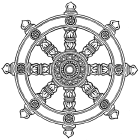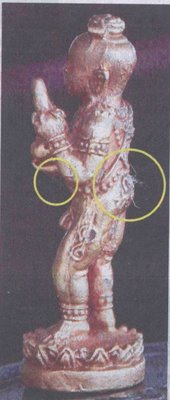 The Noble Eightfold Path is the first method of practice taught by the Buddha at the Deer Park in Benares, soon after His enlightenment. Through the ages followers tend to preceive them as 8 separate paths that can be categorized into the 3 foundations of the path to Nibbana - Sila (morality), Samadhi (concentration) & Panna (wisdom). But in reality, although there are 8 paths, 1 path encompass all the others. Which is that? The path of Right Understanding/ View. The Avatamsaka Sutra says:
The Noble Eightfold Path is the first method of practice taught by the Buddha at the Deer Park in Benares, soon after His enlightenment. Through the ages followers tend to preceive them as 8 separate paths that can be categorized into the 3 foundations of the path to Nibbana - Sila (morality), Samadhi (concentration) & Panna (wisdom). But in reality, although there are 8 paths, 1 path encompass all the others. Which is that? The path of Right Understanding/ View. The Avatamsaka Sutra says:"Without views one maintains the Right View,
To see all things as they truly are;
If you hold on to any Dhamma views,
You will not be able to see the Dhamma at all."
To have Right Understanding first one should let go of all conceptions and views with regard to what is the true Dhamma. When all conceived ideas are disgarded, until there is nothing left to disgard, the Dhamma will reveal itself. So to have right understanding is actually to see one's mind as it really is, rather than just hanging on to doctrinal concepts like Dukkha (suffering), Anicca (impermanace) & Anatta (no-self).
When one has Right Understanding, craving, anger & ignorance are no different from the Buddha mind - that is called Right Thought.
The things you say are all fingers point to the moon (the absolute truth) - that is called Right Speech.
Whether walking, standing, sitting or lying down, you are totally at peace with yourself - that is Right Action.
Whatever occupation you do, u do it with a undistracted mind - that is Right Occupation.
Such an undistracted mind cannot be defiled and thus requires no effort - that is Right Effort.
Because it is fundamentally pure, awareness and unawareness becomes non-dual - that is Right Mindfulness.
Once this mind is realized, one will never lose it again - that is Right Concentration.
And so from this you see, one is all and all is one. Free yourself from concepts and do not let your mind be stagnated. That is what we call the Panna Paramita (wisdom perfection) of the Buddhas.


 As we all know, Wat Phakho is the temple where LP Tuad resided during his youth, before he travelled to Ayuthaya to further his Dhamma studies. This temple is located on the Phiphetasing Hill and therefore we need to climb up the hill to reach it. This long flight of steps are flanked by Nagas, which is a distinct feature of hilltop temples in Thailand.
As we all know, Wat Phakho is the temple where LP Tuad resided during his youth, before he travelled to Ayuthaya to further his Dhamma studies. This temple is located on the Phiphetasing Hill and therefore we need to climb up the hill to reach it. This long flight of steps are flanked by Nagas, which is a distinct feature of hilltop temples in Thailand. Near the entrance we are greeted by 2 statues of LP Tuad, in Samatid as well as Dhutanga postures. This temple was built many centuries ago (in 1514 AD) and houses many ancient objects & artifacts, many belonging to LP Tuad.
Near the entrance we are greeted by 2 statues of LP Tuad, in Samatid as well as Dhutanga postures. This temple was built many centuries ago (in 1514 AD) and houses many ancient objects & artifacts, many belonging to LP Tuad. The side hall is where the revered golden image of LP Tuad is kept, covered from head to toe with gold leaf. You can almost feel LP Tuad's presence here in the Sala.
The side hall is where the revered golden image of LP Tuad is kept, covered from head to toe with gold leaf. You can almost feel LP Tuad's presence here in the Sala. The main Chedi (Stupa) of the temple below is a well known symbol of Wat Phakho.
The main Chedi (Stupa) of the temple below is a well known symbol of Wat Phakho. 
 It was renovated in recent years and given a fresh coat of white paint. It is said to house the Buddha's Footprint; notice the mystical aura or glow surrounding the Chedi. This a definitely a place of great power.
It was renovated in recent years and given a fresh coat of white paint. It is said to house the Buddha's Footprint; notice the mystical aura or glow surrounding the Chedi. This a definitely a place of great power. A small Chedi below the main one caught my eye. In front of the Chedi is a statue of a young boy. Could this be a stupa of Kumantong or maybe just one of the young novices of this temple?
A small Chedi below the main one caught my eye. In front of the Chedi is a statue of a young boy. Could this be a stupa of Kumantong or maybe just one of the young novices of this temple?  A tall white Chedi behind the main one. This probably belongs to one of the past abbots.
A tall white Chedi behind the main one. This probably belongs to one of the past abbots.  The golden reclining Buddha (Phra Non) statue in the pavillion (Sala). He smiles radiantly towards all sentient being who come and worship at the temple.
The golden reclining Buddha (Phra Non) statue in the pavillion (Sala). He smiles radiantly towards all sentient being who come and worship at the temple.
 The main prayer hall (Bot) of the temple houses 3 southern styled Buddha statues as well as another seated image of LP Tuad. As we can see, there's an intricate web of white string below the roof, used for consecration of sacred amulets & images.
The main prayer hall (Bot) of the temple houses 3 southern styled Buddha statues as well as another seated image of LP Tuad. As we can see, there's an intricate web of white string below the roof, used for consecration of sacred amulets & images. One of my favorite Buddhas, Phra Sangajai or Maitreya (to the Chinese) located at the back of the temple, overlooking the South China Sea.
One of my favorite Buddhas, Phra Sangajai or Maitreya (to the Chinese) located at the back of the temple, overlooking the South China Sea. The old court house - Wat Phakho used to be the religious & political centre on this side of Songkhla, and therefore all legal matters were discussed here around 300 years ago. But it had long been converted into another Sala for people to worship.
The old court house - Wat Phakho used to be the religious & political centre on this side of Songkhla, and therefore all legal matters were discussed here around 300 years ago. But it had long been converted into another Sala for people to worship.  A life-sized wax image of LP Tuad, and yes, his magical crystal ball! According to the legend, this crystal ball is given to him by a python (probably a Naga) when he was a baby, and had followed LP Tuad ever since.
A life-sized wax image of LP Tuad, and yes, his magical crystal ball! According to the legend, this crystal ball is given to him by a python (probably a Naga) when he was a baby, and had followed LP Tuad ever since.  I could not go near it as the whole thing was protected by a glass chamber. However, as it was raining heavily at that time, I sat down and meditated outside the chamber in order to feel the energy radiating from the ball. It was a blissful experience! When the rain became lighter, I made my way down to hill and proceeded on my way back to Had Yai. This was without a doubt, one of my most memorable temple tours I took to Thailand. Hopefully I can also visit Wat Changhai (in Pattani), where LP Tuad attained enlightenment when it is safe from the terrorist threat. May the Dharmakaya of LP Tuad protect everyone, sadhu.
I could not go near it as the whole thing was protected by a glass chamber. However, as it was raining heavily at that time, I sat down and meditated outside the chamber in order to feel the energy radiating from the ball. It was a blissful experience! When the rain became lighter, I made my way down to hill and proceeded on my way back to Had Yai. This was without a doubt, one of my most memorable temple tours I took to Thailand. Hopefully I can also visit Wat Changhai (in Pattani), where LP Tuad attained enlightenment when it is safe from the terrorist threat. May the Dharmakaya of LP Tuad protect everyone, sadhu.